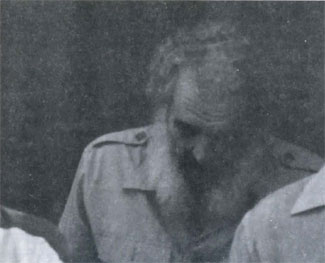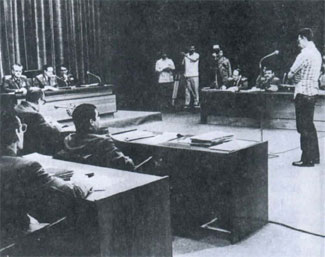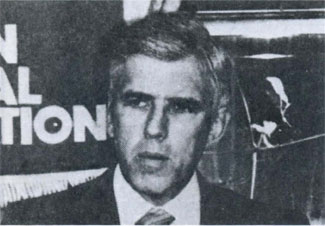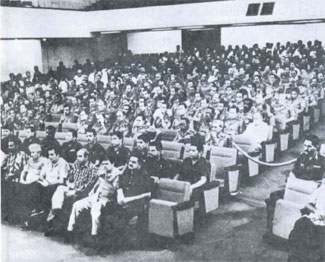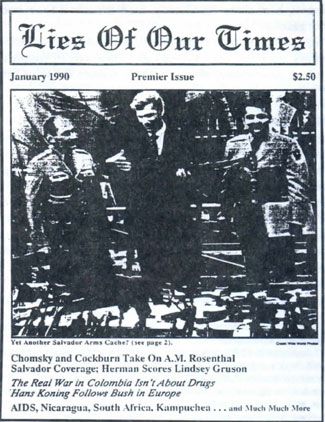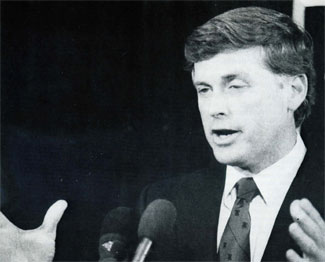by Diana Reynolds*
Winter 1990
NOTICE: THIS WORK MAY BE PROTECTED BY COPYRIGHT
YOU ARE REQUIRED TO READ THE COPYRIGHT NOTICE AT THIS LINK BEFORE YOU READ THE FOLLOWING WORK, THAT IS AVAILABLE SOLELY FOR PRIVATE STUDY, SCHOLARSHIP OR RESEARCH PURSUANT TO 17 U.S.C. SECTION 107 AND 108. IN THE EVENT THAT THE LIBRARY DETERMINES THAT UNLAWFUL COPYING OF THIS WORK HAS OCCURRED, THE LIBRARY HAS THE RIGHT TO BLOCK THE I.P. ADDRESS AT WHICH THE UNLAWFUL COPYING APPEARED TO HAVE OCCURRED. THANK YOU FOR RESPECTING THE RIGHTS OF COPYRIGHT OWNERS.
Since the advent of changes which took place during the Reagan regime, America has been a presidential directive away from a civil security state of emergency which, if ever enacted, could create a constitutional crisis equal in severity to the American Civil War.
A national state of emergency can be declared by a concurrent resolution of both houses of Congress or by the President in the case of natural disasters, nuclear war, a massive mobilization in anticipation of an enemy attack on U.S. territory, or domestic civil unrest.
A disturbing shift in policy occurred during the Reagan years which could have profound consequences with respect to civil liberties. Whereas civil defense planning in the past had focused on disaster relief, the national security focus of the Reagan administration meant implementing new ways to expand police powers in times of nuclear war, domestic unrest, or civil disorder. [1] Bending under pressure brought by the Reagan Administration, Congress gave the president and his executive agencies sweeping emergency powers. This article will examine how those powers came to be, and will explore a possible scenario-the U.S. government's war on drugs-in which these powers might be used.
Civil Security Planning
Since WWII, the U.S. government has had contingency plans in preparation for a large scale disaster or attack. However, during the last twenty-five years - beginning with civil unrest at the height of the Vietnam War-the government's plans have increasingly on focused ways of controlling political dissent.
On October 30, 1969, President Richard Nixon issued Executive Order 11490, "Assigning Emergency Preparedness Functions to Federal Departments and Agencies," which consolidated some 21 operative Executive Orders and two Defense Mobilization Orders issued between 1951 and 1966 on a variety of emergency preparedness matters.
In 1976 President Gerald Ford ordered the Federal Emergency Preparedness Agency (FEPA) to develop plans to establish government control of the mechanisms of productions and distribution, of energy sources, wages and salaries, credit and the flow of money in American financial institutions in any (heretofore undefined) "national emergency." This Executive Order (EO 11921) also indicated that, when a state of emergency is declared by the President, Congress could not review the matter for a period of six months. [2]
Even arch-conservative activist Howard J. Ruff was quick to point out that, since the enactment of EO 11490, "The only thing standing between us and a dictatorship is the good character of the President and the lack of a crisis severe enough that the public would stand still for it. ... " [3]
While Ruff thought a national emergency might be used to destroy the free markets in the U.S. and take away the C.B. radios and guns of Americans, The Washington Afro-American was alarmed for more rational and obvious reasons. In an editorial, the paper repeated Ruffs warning:
Executive Order No. 11490 is real, and only the lack of a crisis big enough, a president willing enough, and a public aroused enough to permit it to be invoked, separates us from a possible dictatorship, brought about under current law, waiting to be implemented in the event of circumstances which can be construed as a "national emergency." [4]
President Carter evidently did not share this concern and, in 1977, he signed Executive Order 12148 which created the Federal Emergency Management Agency (FEMA) to replace the Federal Emergency Preparedness Agency. This Presidential Directive mandated an interface between the Department of Defense (DOD) and FEMA for civil defense planning and funding. [5]
When Ronald Reagan came to power he gave FEMA vast- 1y expanded executive emergency powers and appointed retired National Guard General Louis O. Giuffrida as his "emergency czar." Giuffrida's creation of contingency emergency plans to round up "militant negroes" while he was at the Naval War College caught the attention of then-Governor of California Reagan and his executive secretary Edwin Meese III.
As Governor, Reagan called on Giuffrida to design Operation Cable Splicer. Cable Splicer I, II and III were martial law plans to legitimize the arrest and detention of anti-Vietnam war activists and other political dissidents. [6] In 1971, Governor Reagan, with a $425,000 grant from the Federal Law Enforcement Assistance Administration, established a counterterrorism training center - the California Specialized Training Institute (CSTI) - and made Giuffrida its commandant. [7]
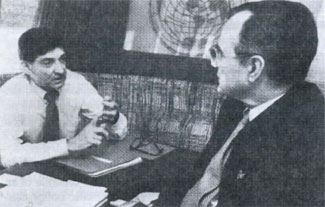
Credit: White House Photo
Louis Giuffrida and George Bush discuss disasters.
Shortly after he assumed the directorship of FEMA in 1981, Giuffrida had flooded high-level FEMA posts with friends from CSTI and the military police, [8] had created a Civil Security Division of FEMA, and had established a Civil Defense Training Center in Emmitsburg, Maryland - based on the CSTI model. By 1984, the Center had trained one thousand civil defense personnel in survival techniques, counterterrorism and military police methods. [9]
From February to July of 1982, President Reagan signed a series of National Security Decision Directives (NSDD) -- presidential decisions on national security objectives - on civil defense policy and emergency mobilization preparedness. While Reagan's real U.S. civil defense policy is contained in the classified NSDD 26, some of the law enforcement and public safety provisions of the policy are made public in NSDD 47. This National Security Decision Directive provides for an intensified counterintelligence effort at home and the maintenance of law and order in a variety of emergencies, particularly terrorist incidents, civil disturbances, and nuclear emergencies. [10]
Reagan gave the National Security Council (NSC) authority over the planning for civil defense policy with its expanded civil security powers. He mandated the creation of a senior-level interdepartmental board, the Emergency Mobilization Preparedness Board (EMPB) and charged it with responsibilities for policy and planning guidance, coordination of planning, resolution of issues, and monitoring progress. [11]
The members of the EMPB were the Assistant for National Security Affairs (as its Chair), the DOD's Secretary of Defense for Policy, the Director of the Joint Chiefs of Staff, and representatives from 10 other federal agencies. FEMA provided the staff, support secretariat and operational supervision for the EMPB and their working group on civil defense. According to then Secretary of Defense Caspar W. Weinberger, by February 1983, the EMPB had prepared - and the President had approved - a national policy statement on emergency mobilization preparedness. [12]
Oliver North served on the EMPB, having been assigned there from 1982 to 1984 by former National Security Advisor Robert McFarlane. General Giuffrida was there too, providing operational supervision. By forming the EMPB, Ronald Reagan made it possible for a small group of people under the authority of the NSC, to wield enormous power. [13] They, in turn, used this executive authority to change civil defense planning into a military/police version of civil security.
Military Rule
In January of 1982, FEMA and the Department of Defense issued a joint paper entitled, "The Civil/Military Alliance in Emergency Management" which specified many of the provisions of Reagan's policy on emergency mobilization preparedness. This document indicates that FEMA had been given cane blanche emergency powers to acquire resources from federal and state agencies (including National Guard personnel) and the private sector (banking, communications, transportation, etc.) "for use in civil disturbance operations." [14]
Apparently General Frank S. Salcedo, Chief of FEMA's Civil Security Division and Giuffrida's former colleague at CSTI, wanted more. In 1983, in a workshop at the annual meeting of the Academy of Criminal Justice Sciences, Salcedo recommended expanding FEMA's power further in the areas of survivability training, research on imposing martial law, and the potential threat posed by foreign and domestic adversaries. As he saw it at least 100,000 U.S. citizens, from survivalists to tax protesters, were serious threats to civil security.
Salcedo saw FEMA's new frontier in the protection of industrial and government leaders from assassination, and of civil and military installations from sabotage and/or attack, as well as the prevention of dissident groups from gaining access to U.S. opinion or a global audience in times of crisis. [15]
"This Is Only A Test, Repeat ... "
It came to light that while FEMA has been expending the lion's share of its energy and funding on building a civil security infrastructure, it had neglected its authorized civil defense role.
While improving capabilities to respond to civil security emergencies was for the most part a planning activity with the Reagan Administration, FEMA was also active in exercises to test these plans. In 1981, FEMA and DOD began a continuing tradition of biannual joint exercises to test civilian mobilization, civil security emergency and counterterrorism plans using such names as "Proud Saber/Rex-82," "Pre-Nest," and "Rex-84/Night Train." [16]
The Rex-84 Alpha Explan (Readiness Exercise 1984, Exercise Plan), indicates that FEMA in association with 34 other federal civil departments and agencies conducted a civil readiness exercise during April 5-13, 1984. It was conducted in coordination and simultaneously with a Joint Chiefs exercise, Night Train 84, a worldwide military command post exercise (including Continental U.S. Forces or CONUS) based on multi-emergency scenarios operating both abroad and at home. In the combined exercise, Rex-84 Bravo, FEMA and DOD led the other federal agencies and departments, including the Central Intelligence Agency, the Secret Service, the Treasury, the Federal Bureau of Investigation, and the Veterans Administration through a gaming exercise to test military assistance in civil defense. [17]
The exercise anticipated civil disturbances, major demonstrations and strikes that would affect continuity of government and/or resource mobilization. To fight subversive activities, there was authorization for the military to implement government ordered movements of civilian populations at state and regional levels, the arrest of certain unidentified segments of the population, and the imposition of martial rule. [18]
Attorney General William French Smith finally became aware of the abuses of the Emergency Mobilization Preparedness Board operating under the NSC. He admonished McFarlane, Assistant to the President for National Security Affairs, who theoretically chaired the planning group. In a letter dated August 2, 1984, Smith responded to a request by the Office of Management and Budget (OMB) to review, for form and legality, a draft Executive Order revising the powerful EO 11490, assigning emergency preparedness functions to federal departments and agencies. The Attorney General said that apart from the legal review by the Office of Legal Counsel,
... I believe that the draft Executive Order raises serious substantive and public policy issues that should be further addressed before this proposal is submitted to the President. In short I believe that the role assigned to the Federal Emergency Management Agency (FEMA) on the revised Executive Order exceeds its proper function as a coordinating agency for emergency preparedness.
This Department and others have repeatedly raised serious policy and legal objections to the creation of an 'emergency czar' role for FEMA. Specific policy concerns regarding recent FEMA initiatives include the abandonment of the principle of 'several' agency responsibility and the expansion of the definition of severe emergencies to encompass 'routine' domestic law enforcement emergencies. Legal objections relate to the absence of Presidential or Congressional authorization for unilateral FEMA directives which seek to establish new Federal Government management structures or otherwise task Cabinet departments and other federal agencies. [19]
The Fall of FEMA
Smith's letter signaled what seemed to be the beginning of the end for FEMA and Reagan's Emergency Mobilization Preparedness Board. Federal Bureau of Investigation Director William Webster had previously complained when FEMA's Director of Civil Security, General Salcedo, had intruded into the FBI's domestic intelligence jurisdiction under the rubric of counter terrorism. Salcedo was forced to turn over to Webster some 12,000 names he had been compiling on a list of potential threats to civil security. [20]
Furthermore, it came to light that while FEMA had been expending the lion's share of its energy and funding on building a civil security infrastructure, it had neglected its authorized civil defense role. On June 15, 1984, barely a month after Giuffrida filed his glowing accomplishment report with Meese, Robert Guffus, Inspector General of FEMA, wrote a draft report on FEMA's Comprehensive Cooperative Agreements (CCA) (with states) in civil defense preparedness.
He concluded that management actions were needed to improve the effectiveness of programs with state and local governments. In his review of the CCAs he found inadequate FEMA management control, imprecise program guidelines and a lack of personnel resources. Programmatic and financial weaknesses were a result of fiscal mis-management, unclear assignment of responsibilities, overlapping job descriptions, inflated training figures, and lack of written procedures. [21]
McFarlane removed North from the EMPB and assigned him to help with conducting unconventional warfare in Nicaragua. Giuffrida resigned in 1985 after a House subcommittee charged that FEMA was being mismanaged, and it was publicized that Giuffrida had staffed FEMA with his military/police cronies and had allowed $170,000 of agency funds to be used to outfit a deluxe bachelor pad at the Civil Defense Training Academy at Emmitsburg. [22] He now operates a security consulting firm in Washington, D.C. General Salcedo has moved on to be Presidential Liaison to Veterans Organizations at the Veterans Administration.
There is some debate about what happened to the plans for a civil security emergency.· There was a rumored joint investigation conducted by the Defense Department and the CIA into the unconstitutionality of planning for a civil security emergency by several government agencies. Supposedly, the two investigators, Special Forces Lt. Colonel Kvererdas and the CIA's William Buckley, prior to his fatal Beirut assignment, destroyed the plans and the exercise data.
Some believe that much of the planning was incorporated into Vice President Bush's Report from his Task Force on Combatting Terrorism which has inspired civil security contingency planning at the U.S. Immigration and Naturalization Service by an Alien Border Control (ABC) Committee. The working group within the INS was designing plans and programs regarding the control and removal of alien terrorists, potential terrorist aliens and those ''who are likely to be supportive of terrorist activity within the U.S." [23]
The most obvious resting place for the material is the National Security Council. In 1987, Reagan signed another NSDD, number 259, which superseded both NSDD 26, the secret civil defense plan of February 25, 1982 and the unclassified version dated March 16, 1982. Even though the 1987 version is shorter and more vague than its predecessors, no significant changes are evident in civil defense planning and programs from the 1984 EMPB scenarios.
Just before he left office, Reagan signed Executive Order 12656 which assigned new emergency preparedness responsibilities. Reagan's final national security legacy to civil defense planning puts the NSC clearly in charge. In Section 104, EO 12656 states that the NSC is the principal forum for consideration of national security emergency preparedness policy and will arrange for Executive branch liaison with, and assistance to, the Congress and the Federal judiciary on national security emergency preparedness matters.
The Director of FEMA has now been promoted to advisor to the NSC on mobilization preparedness, civil defense, continuity of government, technological disasters, "and other issues, as appropriate." The Director of FEMA is also authorized to assist in the implementation of national security emergency preparedness policy by coordinating federal departments and agencies; as well as state and local governments. The exercise program is to continue and plans and procedures ''will be designed and developed to provide maximum flexibility to the President for his implementation of emergency actions." [25]
On the same day that Reagan signed EO 12656 he also signed the Anti-Drug Abuse Act of 1988 which provided yet another in a series of get-tough-but-do-nothing drug policies produced by the Reagan Administration. If and when the Anti-Drug Abuse Act fails-a victim of underfunding and bureaucratic in-fighting-then Executive Order 12656 could become an historic document in the war on drugs.
The National Security State and the Drug War
The U.S. government's proposed ''war on drugs" is one such case in which the U.S. government will have the authority to use the national security apparatus to suppress civil liberties. It may be the first opportunity to call into action the years of planning and expense used to develop the emergency preparedness network.
The Anti-Drug Abuse Act was passed in the final hours of the 100th Congress, when incumbents were anxious to return to their districts in order to campaign and when public opinion was calling for drastic action in the war on drugs. The Act was quickly drafted by ad hoc congressional committees and private consultants, then passed by Congress without the usual legislative hearings and debate.
The Act broadly defines the programs, goals, guidelines and appropriations for all the 58 federal departments plus the thousands of state and local agencies involved in the national war on drugs. Some provisions were made for drug education, prevention, treatment and rehabilitation, but much of the text focuses on the punitive measures to be taken by the government.
The Act increases state powers in the areas of government surveillance, intelligence gathering and seizure of private property.
The anti-drug policy authorizes the use of the U.S. military to assist in the drug war at home. If you live in federal housing or if you reside in large urban areas such as New York, Boston, Washington DC, or Los Angeles - where crime and addiction have turned neighborhoods into combat zones -- this Act will authorize the military to fence off your streets, keep track of who comes from and goes to your home, stop and frisk you, your friends and family, and regularly inspect your home and belongings. IT you or anyone who visits you is suspected by the authorities of using, selling or trafficking in any kind of illicit narcotic substance, you can be evicted from your home whether your landlord is the government or a private party. [27]
The Act increases state powers in the areas of government surveillance, intelligence gathering, and seizure of private property. It authorizes regional intelligence sharing centers, which not only compile statistics but provide contracts to states, local criminal justice agencies, and non-profit organizations for purposes of identifying, targeting and removing criminal conspiracies and activities spanning jurisdictional boundaries. [28]
The Justice Department is given the power to confiscate private property and deny state and federal entitlement by decree. Once caught, even casual marijuana users could be subject to the confiscation of their homes, cars, and bank accounts. [29] The government seizure takes place through civil proceedings where the burden is on the defendant to prove his or her innocence, unlike the "innocent until proven guilty" due process guarantee of criminal proceedings. [30]
A National Drug Czar
William Bennett, as the Director of the Office of National Drug Policy, is an adviser to and voting member of the National Security Council. [31] It is here in the NSC that the ultimate drug war could be fought. All it would take is a President determined enough, a Congress pliant enough, and people desperate enough for the drug war in America to be declared a national security emergency. IT and when that happens, the NSC -- as part of civil emergency preparedness - would be in charge of its implementation under the guidance of the President.
A national security emergency would without a doubt decrease drug use in America. The government would be authorized to increase domestic intelligence and surveillance of U.S. citizens. State security measures would be enhanced by restricting the freedom of movement within the U.S. and granting the government authority to relocate large groups of civilians at will. The U.S. Continental Forces and a federalized National Guard could seal off borders and take control of U.S. airspace, all ports of entry, and interstate highways. [32] It was James Madison's worst nightmare that a righteous faction would some day be strong enough to sweep away the constitutional restraints, designed by the framers to prevent the tyranny of centralized power, executive privilege and arbitrary government authority over the individual. [33] These restraints, the balancing and checking of powers among branches and layers of government and the civil guarantees contained in the Bill of Rights would be the first casualties in a drug-induced national security state with Reagan's civil emergency preparedness unleashed.
Nevertheless, there will be those who will welcome the National Security Council into the drug fray, believing that increasing state police powers to emergency levels is the only way left to fight America's enemy within. In the short run, a national security state would probably be a relief to those whose personal security and quality of life has been diminished by drugs or drug related crime. And as the general public watches the progression of institutional chaos and social decay, they too may be willing to pay the ultimate price: one drug-free America for 200 years of democracy.
_______________
Notes:
* Diana Reynolds is a Research Associate and Program Director at the Edward R Murrow Center, The Fletcher School, Tufts University. She is also an Assistant Professor of Politics, Bradford College and a Lecturer at Northeastern University. Research assistance for this article was provided by Charles Haber.
1. Alfonso Chardy, "Reagan Aides and the 'Secret' Government: ' The Miami Herald, July 5, 1987.
2. Executive Order 11921, "Emergency Preparedness Functions," June 11, 1976: The Federal Register, vol. 41, no. 116 (Washington, DC: Government Printing Office (GPO), June 15, 1976), pp. 24294-300.
3. Howard Ruff, How to Prosper During the Coming Bad Years (New York, NY: Warner Books, 1979), p. 150.
4. Editorial, "The Implications of Miami!," The Washington Afro-American, May 31, 1980.
5. Executive Order 12148, June 13, 1977, as cited in, '''!be Civil/Military Alliance In Emergency Management," FEMA and DOD (Washington, DC: GPO, 1982); for a comprehensive review of FEMA's activities from 1979 to 1985 see: Keenen Peck, "'!be Take Charge Gang," The Progressive, May 1985, pp. 17-24.
6. Edwin Meese III, Executive Secretary to Governor Reagan, Speech transcript, Law Enforcement and Administration Association meeting, San Francisco, CA, March 5, 1970.
7. Ken Lawrence, "The New State Repression," CovertAction Information Bulletin, Number 24 (Summer 1985), pp. 6-9.
8. Howard Kurtz, "Retired Military Policemen Troop Into Highly Paid Agency Jobs," The Washington Post, February 3, 1985.
9. Louis O. Giuffrida, "Memorandum For Edwin Meese III, Counselor to the President," (Washington, DC: FEMA, May 16, 1984), p. 5.
10. National Security Decision Directive 47, "Emergency Mobilization Preparedness," July 22, 1982, p. 10.
11. Ibid., p. 12. From 1982-1988, a new secret Defense Mobilization Planning Systems Agency under the authority of then Vice President George Bush spent more than $3 billion upgrading command, control, and communications links in FEMA's continuity of government infrastructure. For a more comprehensive discussion of this agency see: Steve Emerson, "America's Doomsday Project," U.S. News and World Report, August 7, 1989, pp. 26- 30.
12. Op. cit., n. 10.; also see Caspar W. Weinberger, Secretary of Defense, Annual Report To The Congress, Fiscal Year 1984 (Washington, DC: GPO, 1983), p. 261.
13. Ben Bradlee, Jr., Guts and Glory: The Rise and Fall of Oliver North (New York, NY: Donald I. Fine, Inc., 1988), pp. 132-135; also see Roy Gutman, Banana Diplomacy: The Making of American Policy in Nicaragua 1981- 1987(New York, NY: Simon and Schuster, 1988); Hedrick Smith, The Power Game (New York, NY: Random House, 1988).
14. FEMA/DOD, '''The Civil Military Alliance in Emergency Management." A background paper to support the Civil/Military Action Officer Planners Conferences on Military Support of Civil Defense and Land Defense of CONUS, San Francisco, CA, January 26-29, 1982; New York, NY February 9-12, 1982.
15. Frank S. Salcedo and Richard Fierman, "The Fifth Horseman of the Apocalypse: Civil Security During and After the Unthinkable," Speech transcript, Academy of Criminal Justice Sciences Annual Meeting, March 5, 1983.
16. Caspar W. Weinberger, Secretary of Defense, Annual Report To The Congress, FY 1984 (Washington, DC: GPO, February 1, 1983); also see FEMA, Exercise PRENEST84 (Washington, DC: FEMA, September 1983).
17. FEMA, REX-84 ALPHA: Exercise Plan (Washington, DC: FEMA, February 28, 1984), pp. 24.
18. Joint Chiefs of Staff, Joint Exercise Division, Operations Directorate, in Coordination with Plans and Policy Directorate, Military Support of Civil Defense System Description (Washington, DC: Joint Chiefs of Staff, December 1, 1983), pp. 14.
19. William French Smith, U.S. Attorney General, to The Honorable Robert C. McFarlane, Assistant to the President for National Security Affairs, August 2, 1984.
20. Deposition of Daniel Sheehan, United States District Court, Southern District of Florida, Tony Avirgan and Martha Honey v. John Hull, et. al., 1984.
21. Robert Guffus, Inspector General, FEMA, "Draft Report # H-7-84 - Management Actions are Needed to Improve the Effectiveness of Programs with State and Local Governments," (Washington, DC: FEMA, June 15, 1984). According to FEMA's "Budget in Brief for FY 1990," the net of total agency obligations for 1990 are $1.45 billion. (This is nearly equal to the total budget authority of $15 billion for the Justice Department for 1989). Of this only 1% ($9 million) is allocated for earthquake and other hazards and $280 million for disaster relief.
22. Op. at., n. 8; Pete Earley, "Smith Accuses FEMA of Grab for Power," Washington Post, September 3, 1984.
23. Robert J. Walsh, Assistant Commissioner, Investigations Division, Immigration and Naturalization Service, "Alien Border Control Committee," (Washington, DC: Immigration and Naturalization Service, October 1, 1986).
24. Executive Order 12656, "Assignment of Emergency Preparedness Responsibilities, November 18, 1988," Federal Register, vol. 53, no. 266 (Washington, DC: GPO, November 23, 1988).
25. Ibid., p. 47492.
26. Daniel Patrick Moynihan, "Commitment to Drug Treatment is the Law," New York Times, September 17, 1989.
27. Anti-Drug Abuse Act of 1988, November 18, 1988, Public Law 100- 690: 100th Congress, Title I, Section 1005, paragraph (c), p.4186; also see Bernard Weintraub, "Bush Considers Calling Guard To Fight Drug Violence in Capitol [sic]," New York Times, March 21, 1989; Michael Isikoff, "Bennett Plans War On Drugs in D.C. Area," Washington Post, March 19, 1989.
28. Anti-Drug Abuse Act of 1988, Ibid., Title I, Section 6101, paragraph (a), p. 4340.
29. Ibid., Title V, "User accountability."
30. For all of its draconian prescriptions, however, the U.S. anti-drug policy is, in effect, a paper tiger. On September 5, 1989, George Bush announced his strategy for carrying out the policies outlined by Reagan's Anti-Drug Abuse Act of 1988. Although the Bush strategy implements only a portion of Reagan's policy for a drug-free America by 1995, professionals in law enforcement, the judiciary, the military, health, and education know that even Bush's piecemeal strategy cannot be funded nor administrated. Low estimates indicate that $50 billion dollars will be required over the next four years to implement Bush's present battle plan. The money is unlikely to come from federal taxes. Overburdened and underfunded state and local governments are expected to come up with the majority of the revenues and personnel needed to implement the federal anti-drug policy. In the long run, according to state and local officials, the policy will be very costly to state and local agencies because of further proposed Congressional cuts in social services and education in order to fund the federal government's drug war.
31. Op. cit., n. 27, Section 1003, paragraph (t), p. 4182; also see Diane Alters, "Bennett's 2 Battles: Drugs and Politics," Boston Globe, January 15, 1989.
32. The Posse Comitatus Act passed by the U.S. Congress in 1879, prohibited the use of federal troops in civilian law enforcement. Legislation passed by Congress from 1981 to 1988 has substantially undermined the Posse Comitatus Act permitting U.S. Continental Forces and active reserves which constitute a portion of each state's National Guard to participate in domestic law enforcement. See: 1982 Department of Defense (DOD) Authorization Act's amendments to title 10 U.S. Code, Sections 371-378 entitled, "Military Cooperation with Civilian Law Enforcement Officials"; DOD Authorization Act for Fiscal Year 1985 which amends title 10 Code by changing the meaning of "active duty" as it relates to Air Guard Reserve personnel; and National Defense Authorization Act, FY 1989 which amends title 10, section 371-378 and adds Sections 379 and 380 for drug interdiction and law enforcement (public Law 100-456, Section 1105). Also see, Maj. Aleksandra M. Rohde, "Pushing the Limits of Posse Comitatus," National Guard Magazine, August 1989, p. 22.
33. James Madison, "Checks and Balances", The Federalist Papers, No. 51.

